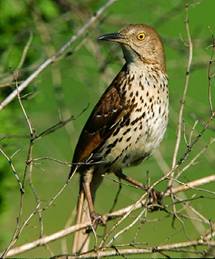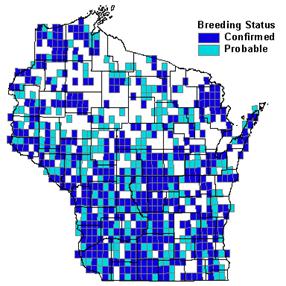Photo by Jack Bartholmai


Status/Protection
- Global Rank: G5 Key to global and state ranks
- State Rank: S4B
- WBCI Priority: SGCN, PIF, State Special Concern
Population Information
The Federal BBS information can be obtained at http://www.mbr-pwrc.usgs.gov/bbs/bbs.html by clicking on Trend Estimates and selecting the species in question. All estimates are for time period (1966-2005).
- Federal Breeding Bird Survey: significant decline
- Federal Breeding Bird Survey (WI): significantly declining
- Federal Breeding Bird Survey (BCR 23): significantly declining
- Federal Breeding Bird Survey (BCR 12): significantly declining
- Chequamegon National Forest Bird Survey (NRRI): non-significant decline (1992-2005)
- WSO Checklist: significantly declining (1983-2007)
Life History
- Breeding Range: Throughout southern Canada and U.S. states east of the Rockies (Cavitt and Haas 2000).
- Breeding Habitat: Pine Barrens, Sand Barrens, Grassland-shrub, and Oak Opening; most grassland/ag types with hedgerows or scattered shrubs.
- Nest: Cup; in low shrubs.
- Nesting Dates: Eggs: early-May to mid-July (Harriman 2006).
- Foraging: Sweeps and probes dry litter on ground.
- Migrant Status: Short-distance migrant.
- Habitat use during Migration: Woody edge habitats including gardens and parks near feeders.
- Arrival Dates: Late April.
- Departure Dates: August to September.
- Winter Range: Oklahoma to North Carolina south, excluding Appalachians.
- Winter Habitat: Woody edge habitats, often near feeders.
Habitat Selection
The Brown Thrasher occurs in a wide variety of habitats, including large clearcut areas with oak or other deciduous tree regeneration. It reaches its highest densities on the edge of shrub habitat or mid-successional forests (Cavitt and Haas 2000). Although an edge species, Brown Thrashers are more likely to occur along fields >6 hectares (Knutson et al. 2001). The Brown Thrasher nests in hedgerows and along the edges of fields, farmsteads, and deciduous forests (Robbins 1991, Knutson et al 2001). Isolated shelterbelts and shrub patches may afford greater nesting success than those close to other wooded habitats (Haas 1997). Isolated patches may be less accessible to mammalian and other types of predators.
Habitat Availability
Brown Thrashers remain widespread in the state and reach some of their highest densities in the large managed barren systems of northwest and northeast Wisconsin (Mossman et al. 1991). However, changing agricultural practices are a conservation concern for this species. Many landowners fail to recognize shrubs as a valuable habitat component (Knutson et al 2001). Consequently, hedgerows have largely been replaced or have grown into mature windbreaks in many agricultural areas. The conversion of barrens habitat due to woody encroachment and fire suppression also reduces suitable habitat for this species (WDNR 2005).
Population Concerns
Brown Thrasher population declines were detected as early as 1903 in Wisconsin (Robbins 1991). Current Breeding Bird Survey data indicate persistent declines statewide (Sauer et al. 2005). However, it remains a common nester across the southwestern two-thirds of the state and a fairly common breeder in the northeastern one-third. During the six-year period of the Wisconsin Breeding Bird Atlas (1995-2000), observers reported Brown Thrashers in 73% of the quads (Harriman 2006).
The loss of barrens and early-seral shrublands are concerns in Wisconsin (WDNR 2005). Brown-headed Cowbird parasitsm does not appear to be a major threat. Brown Thrashers are known to remove cowbird eggs from their nests (Cavitt and Haas 2000).
Recommended Management
Management prescriptions rarely include enhancement of shrub habitats. However, without proper management, shrub habitats lack long-term stability. Efforts are needed to preserve and/or enhance shrubland habitats and mid-successional stages of forest in Wisconsin. Prescribed fire may be a viable management tool to maintain barrens and early-seral shrubland habitats. Brown Thrashers will use areas with frequent burn rotations (annual) as long as a shrub-component remains (Davis et al. 2000). Conservation and management strategies for this species should be focused in the following Wisconsin ecological landscapes: Central Sand Plains, Northeast Sands, Northwest Sands, Southeast Glacial Plains, Southwest Savanna, and Western Coulee and Ridges (WDNR 2005).
Research Needs
Because of their frequent use of farmlands, more research is needed on the Brown Thrasher’s susceptibility to agricultural chemicals. To facilitate better-informed management decisions, more information is needed on the effects of land management practices on nest predation rates (Cavitt and Haas 2000).
Information Sources
- Knutson, M.G., G. Butcher, J. Fitzgerald, and J. Shieldcastle. 2001. Partners in Flight Bird Conservation Plan for The Upper Great Lakes Plain (Physiographic Area 16). USGS Upper Midwest Environmental Sciences Center in cooperation with Partners in Flight. La Crosse, WI.
- Managing Habitat for Grassland Birds: A Guide for Wisconsin: http://www.npwrc.usgs.gov/resource/birds/wiscbird/
- North American Breeding Bird Survey: http://www.npwrc.usgs.gov
- Temple S.A., J.R. Cary, and R. Rolley. 1997. Wisconsin Birds; A Seasonal and Geographical Guide. Wisconsin Society of Ornithology and Wisconsin Department of Natural Resources, Madison, WI.
- Wisconsin Breeding Bird Atlas: http://www.uwgb.edu/birds/wbba/
- David Sample, Grassland Community Ecologist, Wisconsin DNR - 608-221-635.
References
- Cavitt, J.F., and C.A. Haas. 2000. Brown Thrasher (Toxostoma rufum). In the Birds of North America, No. 557 (A. Poole and F. Gill, eds.). The Birds of North America, Inc., Philadelphia, PA.
- Davis, M.A., D.W. Peterson, P.B. Reich, M. Crozier, T. Query, E. Mitchell, J. Huntington, and P. Bazakas. 2000. Restoring Savanna Using Fire: Impact on the Breeding Bird Community. Restoration Ecology 8(1):30-40.
Haas, C.A. 1997. What Characteristics of Shelterbelts are Important to Breeding Success and Return Rates of Birds? American Midland Naturalist 137:225-238. - Harriman, B.R. 2006. Brown Thrasher. In Atlas of the Breeding Birds of Wisconsin. (N.J. Cutright, B.R. Harriman, and R.W. Howe, eds.). The Wisconsin Society for Ornithology, Inc. 602pp.
- Knutson, M. G., G. Butcher, J. Fitzgerald, and J. Shieldcastle. 2001. Partners in Flight Bird Conservation Plan for The Upper Great Lakes Plain (Physiographic Area 16). USGS Upper Midwest Environmental Sciences Center in cooperation with Partners in Flight. La Crosse, WI.
- Mossman, M. J., E. Epstein, and R. Hoffman. 1991. Birds of Wisconsin Pine and Oak Barrens. The Passenger Pigeon 53:137-163.
- Robbins, S. D., Jr. 1991. Wisconsin Birdlife: Population and distribution past and present. Madison, WI: Univ. Wisconsin Press.
- Sample, D. and M. Mossman. 1997. Managing Habitat for Grassland Birds: A Guide for Wisconsin. Wisconsin Department of Natural Resources: Madison, WI.
- Sauer, J. R., J. E. Hines, and J. Fallon. 2005. The North American Breeding Bird Survey, Results and Analysis 1966 - 2004. Version 2005.2. USGS Patuxent Wildlife Research Center, Laurel, MD.
- Wisconsin Department of Natural Resources (WDNR). 2005. Wisconsin’s Strategy for Wildlife Species of Greatest Conservation Need. Madison, WI.
Contact:
- Compiler: Jenny Herrmann, mherrmann4@wi.rr.com
- Editor: Kim Kreitinger, K.Kreitinger@gmail.com
